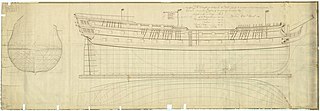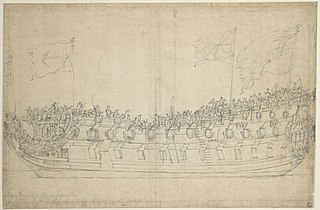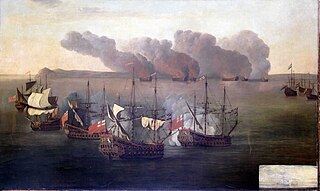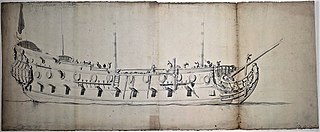
HMS Colossus was a 74-gun third-rate ship of the line of the Royal Navy. She was launched at Gravesend on 4 April 1787 and lost on 10 December 1798. During her years of service she participated in the Battle of Groix, the Battle of Cape St Vincent, and the Battle of the Nile. While carrying wounded from the latter, she was wrecked at the Isles of Scilly. The wreck is a Protected Wreck managed by Historic England.

Association was a 90-gun second-rate ship of the line of the Royal Navy, launched at Portsmouth Dockyard in 1697. She served with distinction at the capture of Gibraltar, and was lost in 1707 by grounding on the Isles of Scilly in the greatest maritime disaster of the age. The wreck is a Protected Wreck managed by Historic England.

HMS Resolution was a 70-gun third-rate ship of the line of the Royal Navy, launched at Harwich Dockyard on 6 December 1667. She was one of only three third-rate vessels designed and built by the noted maritime architect Sir Anthony Deane.

HMS Stirling Castle was a 70-gun third-rate built at Deptford Dockyard, in 1678/79. She was in active commission for the War of the English Succession, fighting in the Battles of Beachy Head and Barfleur. HMS Stirling Castle underwent a rebuild at Chatham Dockyard in 1699. She was in the Cadiz operation in 1702. The ship was wrecked on the Goodwin Sands off Deal on 27 November 1703. The remains are now a Protected Wreck managed by Historic England.
HMS Northumberland was a 70-gun third-rate ship of the line of the Royal Navy, built by Francis Bayley of Bristol in 1677/79. She partook in the last great battle of the War of English Succession and the first battle of the War of Spanish Succession. She was lost in the Great Storm of November 1703.
HMS Restoration was a 70-gun third rate of the Kingdom of England built at Harwich Dockyard in 1677/78. After a ten-year stint in Ordinary she was commissioned for the War of the English Succession in 1690. She fought in the Battles of Beachy Head and the Battle of Barfleur. She was rebuilt at Portsmouth in 1699/1702. She was lost on the Goodwin Sands during the Great Storm of November 1703.

HMS Warspite was a 70-gun third-rate ship of the line of the Royal Navy, launched in 1666 at Blackwall Yard. This second Warspite was one of the five ships designed to carry more provisions and lower deck guns higher above the water than French and Dutch equivalents. In 1665 the Second Anglo-Dutch War had begun and on 25 July 1666 Warspite was one of 23 new English warships helping to beat a Dutch fleet off North Foreland, Kent. She won again distinction on Christmas Day 1666 as senior officer's ship out of five sent to protect an important convoy of naval stores from the Baltic. Warspite next took part in the first action of the Third Anglo-Dutch War on 28 May 1672 off Southwold Bay, Suffolk. This desperate 14-hour battle, generally known as Solebay, was a drawn fight; but Warspite successfully fended off a pair of Dutch fire ships exactly as she had done off North Foreland. By 1685, she was mounting only 68 guns.

Constant Warwick was a 32-gun privateer, built in 1645 as a private venture between the Earl of Warwick and Sir William Batten. Hired for service in the Parliamentarian navy during the First English Civil War, her captain William Batten defected to the Royalists during the 1648 Second English Civil War. After her crew mutinied in November 1648, she returned to England and was purchased by Parliament on 20 January 1649. Described as an "incomparable sailer", she was noted for her sharpness and fine lines, and is considered by some as the first true frigate of the Royal Navy. Mainly used for patrolling, she was captured by the French in 1691.
The English ship Speaker was a 50-gun third-rate. Speaker was built for the navy of the Commonwealth of England by Christopher Pett at Woolwich Dockyard and launched in 1650. At the Restoration she was renamed HMS Mary. She was the prototype of the Speaker-class.

Foresight was a 40-gun fourth-rate of the Commonwealth of England, after the Restoration of the monarchy in 1660 she was incorporated into the Navy of the Kingdom of England. During her time in the Commonwealth Navy she partook in the First Anglo-Dutch war being present in the battles of Dungeness, Kentish Knock, Portland, The Gabbard and Scheveningen. She was also present at the Battle of Santa Cruz and the bombardment of Porto Farina, In the Second Anglo-Dutch War she was involved in the Battle of Vagen and the St James Day Fight. During the Third Anglo-Dutch War she participated in the battles of Schooneveld and Texel. For the remainder of her career she was in the West Indies, the Mediterranean and North American waters. She was wrecked south of Cuba in July 1698.
HMS Assistance was one of six 40-gun fourth-rate frigates, built for the Commonwealth of England under the 1650 Programme, after the Restoration of the monarchy in 1660 she was incorporated into the navy of the Kingdom of England. During her time in the Commonwealth Navy she partook in the First Anglo-Dutch war being present in the battles of Kentish Knock, Portland and The Gabbard. In the Mediterranean she was present at the Battle of Santa Cruz and the bombardment of Porto Farina, In the Second Anglo-Dutch War she was involved in the Battle of Lowestoft, Battle of Vagen and the St James Day Fight. She did not participate in fleet actions after this. She spent the rest of her service life undergoing several rebuilds and plying the waters as a cruiser protecting British trade and projecting British sovereignty. After nearly 95 years of Service she was sunk as a break water at Sheerness at the end of 1745.

The English ship Winsby was a 44-gun fourth-rate frigate, built for the navy of the Commonwealth of England at Great Yarmouth, and launched in February 1654. Winsby was named for the Parliamentarian victory at the Battle of Winceby (1643).
HMS Windsor Castle was a 90-gun second rate ship of the line of the English Royal Navy, built by Thomas Shish at Woolwich Dockyard, and launched in 1679.
HMS Anne was a 70-gun third rate ship of the line of the English, built under the 1677 Construction Programme by Phineas Pett II at Chatham Dockyard during 1677/78. She fought in the War of English Succession 1688 to 1697. She fought in the Battle of Beachy Head where she was severely damaged and ran aground. She was burnt by the English to avoid capture by the French. The wreck is a Protected Wreck managed by Historic England.

HMS Hampton Court was a 70-gun third rate ship of the line of the Royal Navy, launched at Deptford Dockyard in 1678. Her initial commission was to move her to Chatham where she spent in the next ten years in Ordinary. She held an active commission for the War of the English Succession, participating in the Battles of Beachy Head and Barfleur. She was rebuilt at Blackwall in 1699/1701. During the War of Spanish Succession she served mainly in the Mediterranean. In 1707 she was taken by the French and incorporated into the French Navy for four years. She was sold to the Spanish in 1712. She was wrecked in Spanish service off the coast of Florida in a hurricane in 1715.
HMS Burford was a 70-gun third rate ship of the line built at Woolwich Dockyard in 1677/79 as part of the Thirty Ships Programme of 1677. She fought in the War of the English Succession, including the Battle of Barfleur, before being rebuilt at Deptford in 1699, remaining as a 70-gun third rate. During the War of Spanish Succession she was mostly in the Mediterranean fleet and fought at the capture of Gibraltar and the Battle of Málaga in 1704 before being extensively repaired between 1710 and 1712 at Portsmouth Dockyard. Burford served in the Baltic in 1715 and 1717 before returning to the Mediterranean to fight the Spanish at the Battle of Cape Passaro in 1718. She was wrecked on the Italian coast in a storm on 14 February 1719.
HMS Elizabeth was a 70-gun third rate built at Barnards Yard at Deptford Green by William and Robert Castle of Rotherhithe in 1678/80. She held an active commission during the War of the English Succession fighting in all three major engagements. She was rebuilt at Portsmouth between 1699 and 1704. She was captured by the French off the Scilly Islands in November 1704. She was in the French Navy until she was deleted in 1720.
HMS Grafton was a 70-gun third rate built at Woolwich Dockyard in 1677/79. She was delivered to Chatham and placed in Ordinary in 1679. She was commissioned in 1683 to participate in the evacuation of Tangier, Morocco. She served during the War of the English Succession fighting in the Battles of Beachy Head and Barfleur. She was rebuilt in 1699/1701. She was in active commission during the War of Spanish Succession. She fought in the Battle of Vigo, the capture of Gibraltar and the Battle of Velez Malaga. She was taken by the French in 1707 and incorporated into the French Navy. Finally, being broken at Brest in 1744.
HMS Exeter was a 70-gun third rate ship of the line of the Kingdom of England, built by contract Sir Henry Johnson at Blackwall under the 1677 Construction Programme. She was at the Battle of Beachy Head in 1690. She was accidentally burnt at Plymouth in 1691. Her remains were hulked at Portsmouth until she was broken in 1717.
Maritime Archaeology Sea Trust (MAST) is a charitable trust founded in February 2011, which focuses on investigations into the maritime heritage of the United Kingdom and further afield, through historical and archaeological investigations. MAST uses its profits from contract work as well as donations to fund its charitable aims.










